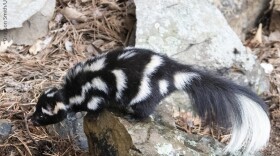A trip to the Red Hills southwest of Medicine Lodge, Kansas, can be an eye opener for both beautiful countryside and an invading horde of Eastern Red Cedars -- a good tree gone bad. Red cedars have been a part of the history of the Great Plains from Texas to Canada, and were once controlled from over-population by natural wildfires. But with the advent of civilization, fires have been controlled to the point that the tree is taking over grazing lands and disastrous results are being reported. Reduced cattle forage, numbers of grassland birds (especially the prairie chicken), lesser numbers of other wildlife, and decreased stands of wildflowers are a result of the forestation of the prairie. One of the most serious side effects is the drain on water supplied from natural aquifers and annual rainfall.
Efforts are being made to educate the landowners and the general public in methods of controlling the vast numbers of red cedars. Controlled burns, better planning of conservation plantings and windbreaks, and development of a red cedar industry to use the excess trees as building material, fence posts, or landscape mulch are in the works. For more information contact the Kansas Chapter of the Nature Conservancy, your University Research and Extension Departments, State Forest Services, or Departments of Wildlife and Parks.








